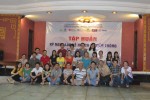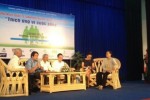A fruitful study tour
From 16 – 20 April, 2015, the Climate Change Network in Central Vietnam (CCN) organized a fruitful and enjoyable study tour for its members. This is one of the activities in the framework of cooperation between Plan International in Vietnam and Center for Rural Development in Central Vietnam (CRD) – Coordinating Organization of CCN.
From the first minutes after boarding the bus, all members of the CCN network were so happy, excited and desired to learn good things and have an enjoyable experience from the study tour. This was presented by every single member when they gave a self-introduction and expression of interest. And the tour absolutely met their expectations within the time limit.
Departuring from Hue city, our group arrived at Dai Lanh commune, Dai Loc district, Quang Nam province after travelling nearly 200km. At this location, we learned about experiences in the implementation of the project “Disability Inclusive Community-Based Disaster Risk Management”. The objective of this project is to enhance the capacity of disaster risk management of flood-prone communities in Quang Nam province, focusing on the needs of people with disabilities and their relatives through the effective participation of the disabled. The communities alternately shared their best practices and implementation techniques despite limited time.

Learning, sharing at Dai Lanh commune
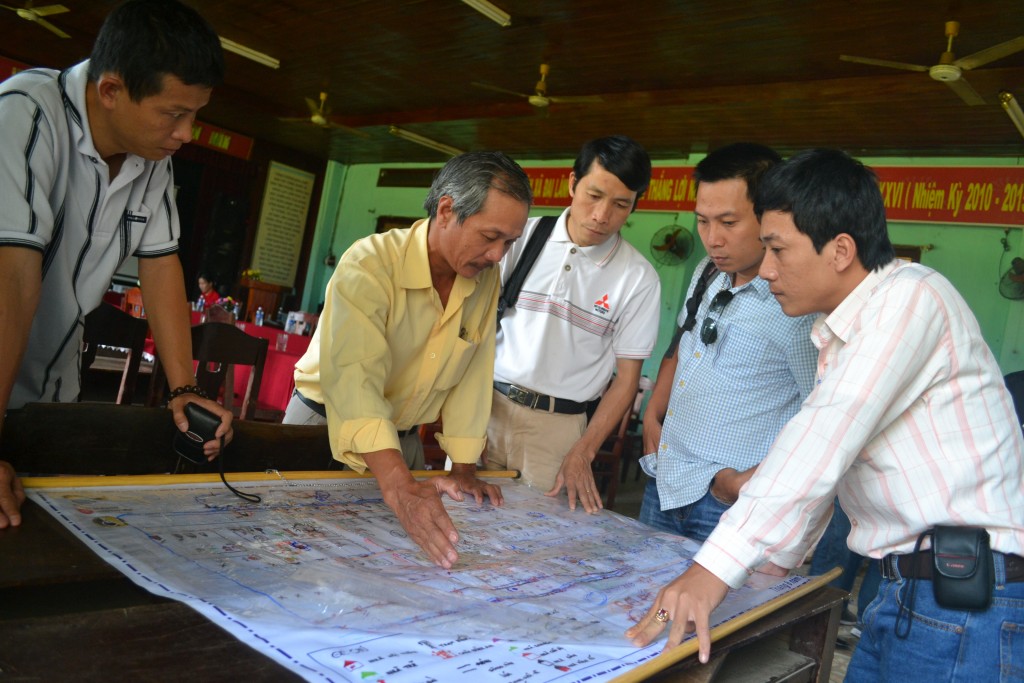
Hazard diagram drawn by the community including people with disabilities
Leaving Dai Lanh commune with strong emotions from the stories of people with disabilities involved in the project, the driver carefully drove us on a narrow, sinuous and winding road, up Truong Son range and over many steep passes to come to the land of Tay Giang in the south of Quang Nam district, bordering with Lao PDR. We had a really good sleep in Prao town located in the majestic Truong Son range.
On the second day, we visited and worked with Bhalêe commune, Tay Giang district. From here, divided into three groups we visited models and other activities at the same time at A Tep 2 village, including: (1) Forestry Land Allocation (FLA) model; (2) Model of planting native rattan; and (3) Activity of using less smoke and firewood saving stoves.
The group interested in the FLA model worked with the district and commune officials and people directly involved in the project and “saw and heard” about the results that the local residents and project had achieved. It is understood that this is the first pilot in Tay Giang district regarding FLA that the locals themselves carried out to survey, measure and record information. The activities such as surveying a standard plot, estimating of forest reserves, using GPS, etc., have been truly effective in spite of the locals being reluctant to practice in the past.

Gifts for A Tep 2, Bhalêe commune
Also in the village A Tep 2, members of the second group visited the model of “Planting native rattan under the forest canopy”. They met members of the interest group and saw green and healthy rattan in the nurseries garden. This model makes sense for the maintenance and development of local breeds in order to develop high quality raw materials for the production of rattan. In addition, it also contributes to climate change mitigation in the context of preventing forest degradation. Specifically, planting rattan under the forest canopy will help protect the surface soil, prevent erosion and develop vegetation under rattan, hold humus, help the forest grow and improve carbon sinks.

Visit and exchange at rattan nurseries

Visit and exchange at rattan nurseries
Like the other two groups, the members of the third group went to explore the activity of “Use of less smoke, firewood-saving stoves”. Different from the other two groups, this group was welcomed by Cơ Tu women who shared information about the effectiveness of the communication campaign to encourage Bhalêe women to change their habit from using conventional wood stoves to invest in and use firewood-saving stoves. This activity economized a large amount of firewood, helping women reduce the time spent on firewood collection. The woman named Avo Thi Be – Chairman of Village Women Union of A Tep 2 said that “Doing the cooking by improved stoves reduced about 60% of conventional firewood, using just 4-5 bars of firewood to cook the rice instead of 10 bars as before”. This activity is very practical and in accordance with the local and was highly appreciated by Bhalêe women. The project had supported just 50 stoves but there are 604 stoves being ordered. It was a success beyond expectations.

Use of firewood-saving stoves – women reduce their labor power

Use of firewood-saving stoves – women reduce their labor power
Saying goodbye to Cơ Tu ethnic people and leaving the mountainous Tay Giang, our group went down to the plain area with so many valuable lessons. According to the schedule, the group came to Duy Tan commune, Duy Xuyen district, Quang Nam province on the third day in a eager manner and desired to gain more experience here. Two models that the group visited and learned about are “Planting vegetables adapting to climate change” and “Raising chicken safe from disease, adapting to climate change” financed by Save the Children with the technical consultancy of Center for Rural Development in Central Vietnam (CRD). The early summer sunshine was intense but did not detract from the spirit of our group members’ learning.
In the context of climate change, the agricultural production will be seriously affected so it is vital to have appropriate interventions to support people to minimize these impacts. Thus, this project was selected to help people adapt to climate change in the agricultural activities. These two models in Duy Tan commune, in addition to adapting to the extreme weather phenomena like heat waves, cold waves, erratic unfavorable weather conditions, it also has great significance in economic terms, especially for the poor.

The joy of the people from the success of the model

Group exchanges in the vegetable garden of Nguyen Ba household – Thu Bon Tay village, Duy Tan commune

Interview Nguyen Ba – Thu Bon Tay village, Duy Tan communee
In the afternoon, we met and talked to the head of household model “Application of water saving irrigation system to plant elephant grass Pennisetum purpurrerum for raising cattle adapting to climate change” in Pho An commune, Duc Pho district, Quang Ngai province. This model belongs to the research project of Institute of Resources and Environment, Hue University. The irrigation system helped save water, reduce time and labor power for farmers, and facilitate for farmers to do other work for extra income. In addition to the tolerance for drought and heat waves, this model is also a direction for the government to consider to plant Varisme grass no. 6 (Pennisetum Purpureum ‘Napier’ VA06 – is a hybrid grass from elephant grass and Pennisetum americanum of American and is considered the “king grass”) on arid sandy areas to develop cattle-breeding. According to the group evaluation, replication of this model at the local level with the similar natural and production conditions is absolutely high.
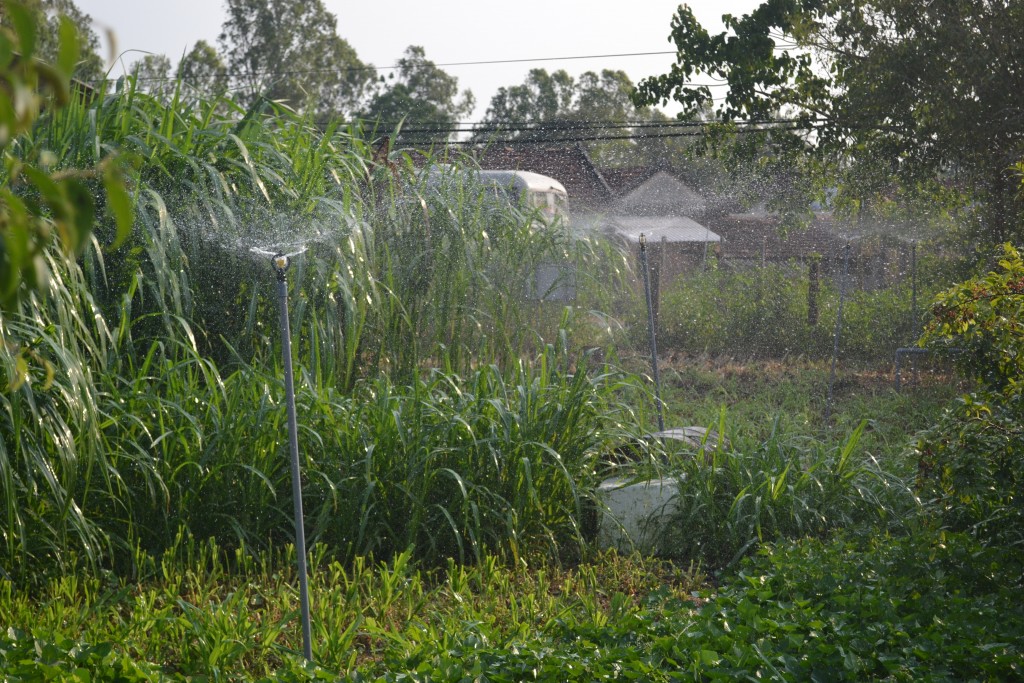
Water saving irrigation system
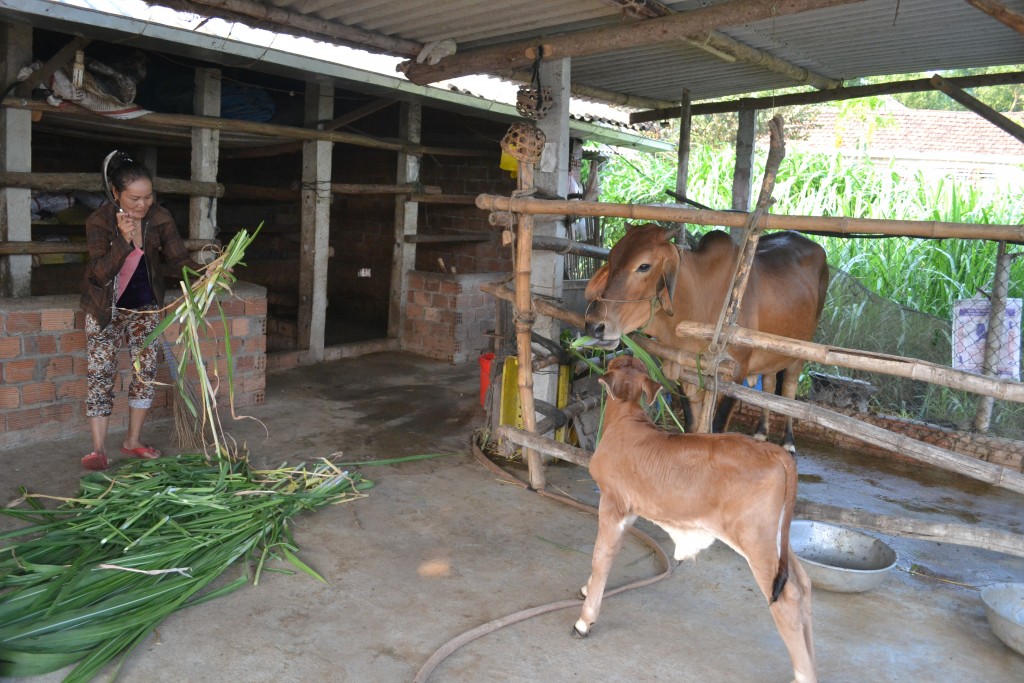
Pennisetum Purpureum ‘Napier’ VA06 – food for tie-rod cowshed
Instead of being more and more tired when travelling for a long time, delegation members were excited more and more. Every member was eager to explore and discover new things, draw lessons-learned for his/her organization and the operation of the CCN in future. Many problems and questions were raised to discuss and exchange on the bus while moving on the road.
On the last day of the schedule, we were working in the provinces of Binh Dinh and Phu Yen, the two most impressive destinations of our delegation. In Binh Dinh province, German Red Cross and Binh Dinh Red Cross shared information about the model “Community-based Disaster Risk Management”. This project has been implemented methodologically. As attractive as the program and content in Binh Dinh, in Phu Yen the delegation worked with the Central Center for Pharmaceutical Research and Production. The model “Production of medicinal plants – converting arable land to cultivate medicinal drought-tolerant plants” at the Center showed the tight coordination of four people (Farmer – Entrepreneur – Scientist and the State) in the context of market oriented production and climate change adaptation. Two models in Binh Dinh and Phu Yen facilitated the delegation’s members in developing many ideas for new projects.

Group working at the Red Cross in Binh Dinh province

Garden researching medicinal plants in Phu Yen province
The organizer of our study tour was also very thoughtful, arranged programs so that all members in the delegation enjoyed many delicacies, specialties at the locals. No one forgot to buy pharmaceuticals, functional foods… at the Central Center for Pharmaceutical Research and Production as gifts for relatives. Everyone was happy and proud to buy these gifts.
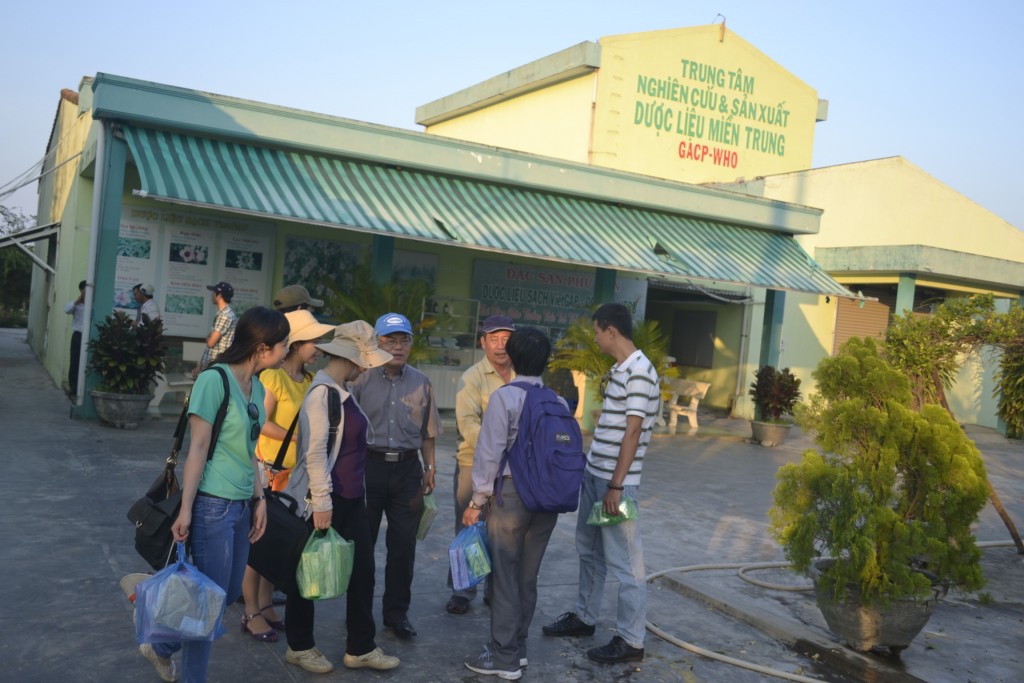
Gifts for loved ones
Turning to the objective of the study tour, the members have gained useful experiences from programs/projects in the Central Region on climate change adaptation and mitigation, and disaster risk management. Every single member of the delegation evaluated that the tour achieved 100% of its objective. They collected a lot of information, good experiences on adaptive livelihood models and disaster risk management models. Besides the highly appreciated results, the organizing board received a number of comments to further improve the effectiveness of study tours and other activities of the network in the future. Along with what was learned in the field, the information gathered from the tour have been updated, summarized and sent to the editors to select and document the documentation for sharing inside and outside the network. The documentation is being rushed to print and shared with other members inside and outside CCN. Moreover, the study tour facilitates CCN’s members become closer and enhances the connectivity and network ownership of member organizations.
We hope that the coming CCN will have many more activities to link and mobilize resources in order to contribute to reduce vulnerability and enhance resilience of communities in the Central region under the impact of natural disasters and climate change.
Author: Tinh Chi and Bao Hoa
Photo: CCN


